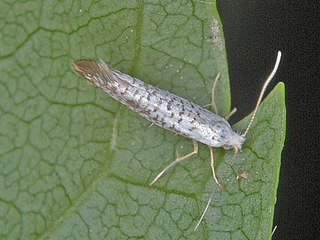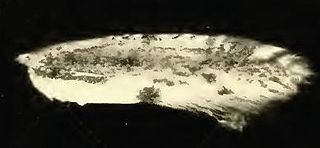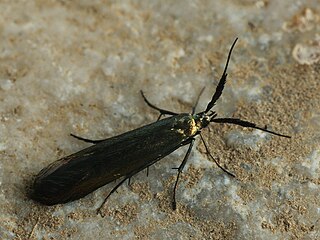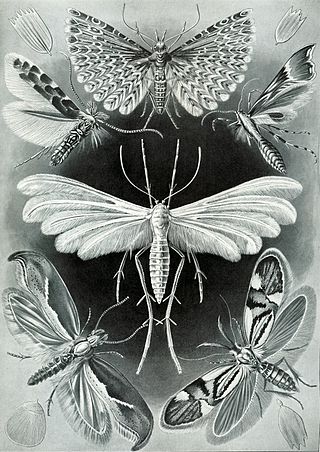
Entomology is the scientific study of insects, a branch of zoology. In the past the term insect was less specific, and historically the definition of entomology would also include the study of animals in other arthropod groups, such as arachnids, myriapods, and crustaceans. This wider meaning may still be encountered in informal use.

Schinia, commonly called flower moths, is a large genus of moths belonging to the family Noctuidae. The genus has a Holarctic distribution with the vast majority of species being found in North America, many with a very restricted range and larval food plant.

Argyresthia is a genus of moths in the family Argyresthiidae, previously treated as subfamily Argyresthiinae in the family Yponomeutidae.
François-Xavier Bélanger was a French-Canadian naturalist and museum curator. An autodidact like many naturalists of the time, he specialized in the study of Microlepidoptera. Thanks to the influence of Léon Abel Provancher and Thomas-Étienne Hamel, he became curator of the zoology museum at Université Laval, where although he did a good job of enlarging the total collection, he did so in a generally poorly organized way. He was succeeded by his assistant curator Charles-Eusèbe Dionne.

Scythropia crataegella, the hawthorn moth, is a species of moth in the monotypic genus Scythropia. It is found in western Eurasia.

Argyresthia curvella is a species of ermine moth. It belongs to subfamily Argyresthiinae, which is sometimes elevated to full family rank in the superfamily Yponomeutoidea. It is commonly called apple blossom tineid, reflecting the fact that it was originally believed to be a tineid moth.

Argyresthia goedartella, the bronze alder moth, is a species of moth of the family Argyresthiidae.

Argyresthia pygmaeella is a moth of the family Yponomeutidae. The species was first described by Michael Denis and Ignaz Schiffermüller in 1775 from a specimen found near Vienna, Austria

Argyresthia retinella is a species of moth of the family Yponomeutidae.
Argyresthia abies is a moth of the family Yponomeutidae first described by Hugh Avery Freeman in 1972. It is found in the Canadian provinces of Alberta, Saskatchewan and northern Ontario.

Argyresthia oreasella, the cherry shoot borer moth, is a moth of the family Yponomeutidae. It is found in North America, including New York, Michigan, Idaho, Missouri, Colorado, New Mexico, California, Quebec, Alberta and Saskatchewan.

Argyresthia belangerella is a moth of the family Argyresthiidae first described by Vactor Tousey Chambers in 1877. It is found in Canada. It might be only a variety of Argyresthia conjugella.
Argyresthia columbia is a moth of the family Yponomeutidae first described by Thomas Nesbitt Freeman in 1972. It is found in Canada in south-eastern British Columbia and is possibly also present in Alberta.
Argyresthia flexilis is a moth of the family Yponomeutidae first described by Hugh Avery Freeman in 1960. It is found in the United States in northern Montana and probably the adjacent parts of Canada.
Argyresthia laricella, the larch shoot moth, is a moth of the family Yponomeutidae. The species was first described by William D. Kearfott in 1908. It is found in Canada, including north-western Ontario, Nova Scotia, south-eastern Manitoba, Saskatchewan, western Alberta and southern British Columbia.
Argyresthia mariana, the graybanded leafroller, is a moth of the family Yponomeutidae. The species was first described by Thomas Nesbitt Freeman in 1972. It is found in Canada in northern Ontario and possibly Alberta.
Argyresthia picea is a moth of the family Yponomeutidae. It is found in Canada, including Alberta, Ontario, Quebec and the Yukon.

Friederike Lienig was an entomologist from the Russian Empire who also resided in the Kingdom of Prussia. Four species of tiny moths are named after her. One is Cosmopterix lienigiella. At first self taught she was later instructed by Philipp Christoph Zeller at the technical high school in Meseritz. She was a Member of the Stettin Entomological Society.

Annette Frances Braun was an American entomologist and leading authority on microlepidoptera, a grouping of mostly small and nocturnal moths. Her special interest was leaf miners: moths whose larvae live and feed from within a leaf.











